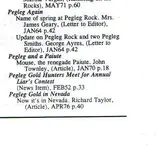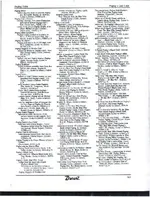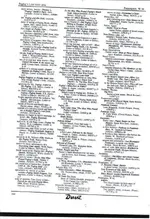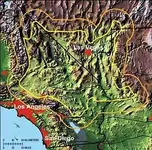Oroblanco
Gold Member
- Joined
- Jan 21, 2005
- Messages
- 7,841
- Reaction score
- 9,872
- Golden Thread
- 0
- Location
- DAKOTA TERRITORY
- Detector(s) used
- Tesoro Lobo Supertraq, (95%) Garrett Scorpion (5%)
MUCHAS GRACIAS mi amigo Pegleglooker!
Now I must point out, if Thomas is not "the" right Pegleg, then why do we find Thomas being named in 1854 newpaper articles? I have run across the John G Smith too, which led me to believe there had to be two Smiths. If the true "original" finder were another Smith than Thomas, shouldn't we find a different name in the oldest accounts? Thank you in advance,
Oroblanco
PS just wanted to add this, that several people vouched for Thomas Smith having gold nuggets in his possession, here is one example
Date: January 16, 1900>
I put several passages in "bold" to highlight that the Pegleg being described as a "hunter and trapper", that Gaskill held the very nuggets in his hands or claims to, and that it is coated with black.
Now I must point out, if Thomas is not "the" right Pegleg, then why do we find Thomas being named in 1854 newpaper articles? I have run across the John G Smith too, which led me to believe there had to be two Smiths. If the true "original" finder were another Smith than Thomas, shouldn't we find a different name in the oldest accounts? Thank you in advance,
Oroblanco
PS just wanted to add this, that several people vouched for Thomas Smith having gold nuggets in his possession, here is one example
<from The San Francisco Call"PEGLEG" MINE IS NOT A MYTH Evidence That It Exists in the Bad Lands. Special Klppatch to The Call SAN* DIEGO. Jan. 15. — It seems that the mysterious "Pegleg" mine has not been entirely given up as a myth, for though many prospectors have sought to locate the scene of the fabulous finds and have failed In the attempt, there are others who are willing to endure all sorts of hardship in searching for the mine .of the eccentric old cripple. Men still believe that the mine will be re-located, and there are those who hope to be the successful searchers, and that at no distant day. There is a gentleman residing in San Diego who knew Pegleg Smith and heard from his lips the story of his discovery. Silas Gasklil, who lives at the corner of Sixteenth and F streets, was a neighbor of Smith at Weberville. after the latter claimed he had found his mine. Gasklll's house was not over 100 yards from the cabin of Pegleg. In the evenings young Gasklil would go over and listen to his neighbor's thrilling tales of his experiences as a hunter and a trapper. Pegleg Smith's deformity was not confined to an* absent limb. He had an everpresent appetite, which was inordinately devoted to the fiery liquid. Silas Gaskill liked to hear the old hunter's tales as well as the latter liked the lurid liquor, and was willing to make a fair exchange by embellishing his visits with a pint bottle of Hangtown whisky. This amount was ample to keep his host's highly colored yarns spinning for one ordinary evening. On one of Gaskill's visits Pegleg told of his trip across the desert when he clalmnd to have found his gold. Mr. Gasklil vouches for the truth of the nuggets being in the possession of old Pegleg. He personally saw and handled them. He is furthermore satisfied that .the mysterious mine is a reality, and that It is "situated somewhere in the "bad lands," which lie directly on the route Pegleg must have taken. The reason, he thinks, no one has yet been able to find the mine is that all who have gone in search of it have looked for the ordinary indications of gold, which he is satisfied are entirely absent. The description Mr. Gasklll gives of the location of the mine as given him by Smith is borne out in every respect by an Indian who lives at Mesa Grande. When a boy this Indian was over in the "bad lands" In company with his father. They also picked! up some pieces of blackcoated metal, which they afterward learned were nuggets of gold. A few months ago tho Indian made an attempt to tlnd the place to which he had been with his father. He did not find the identical spot, but was in the neighborhood of it. and brought back a very rich chunk of ore bearing the black covering. His description of the spot visited by him and his father Includes three hills answering the description of those told of by Peg Leg Smith.
Date: January 16, 1900>
I put several passages in "bold" to highlight that the Pegleg being described as a "hunter and trapper", that Gaskill held the very nuggets in his hands or claims to, and that it is coated with black.









 but have found many times that the "official" dates for the founding of towns and cities, as well as the first "settlers" arriving etc are not too accurate, that earlier settlements and settlers were present than the "official" versions admit. This does not prove that Mojave existed prior to 1876 either.
but have found many times that the "official" dates for the founding of towns and cities, as well as the first "settlers" arriving etc are not too accurate, that earlier settlements and settlers were present than the "official" versions admit. This does not prove that Mojave existed prior to 1876 either.